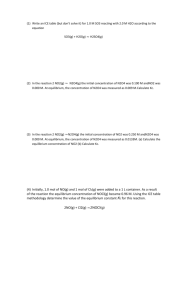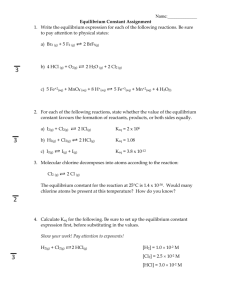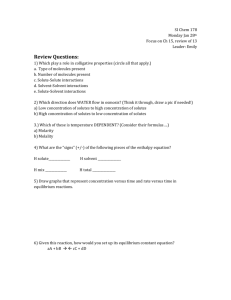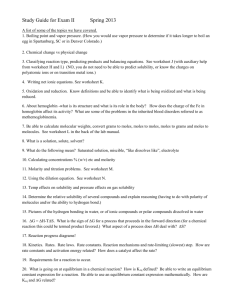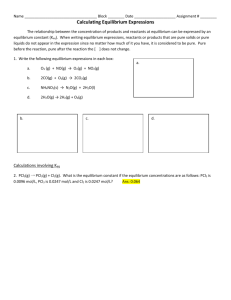Honors Chemistry Keq WORKSHEET #1
advertisement
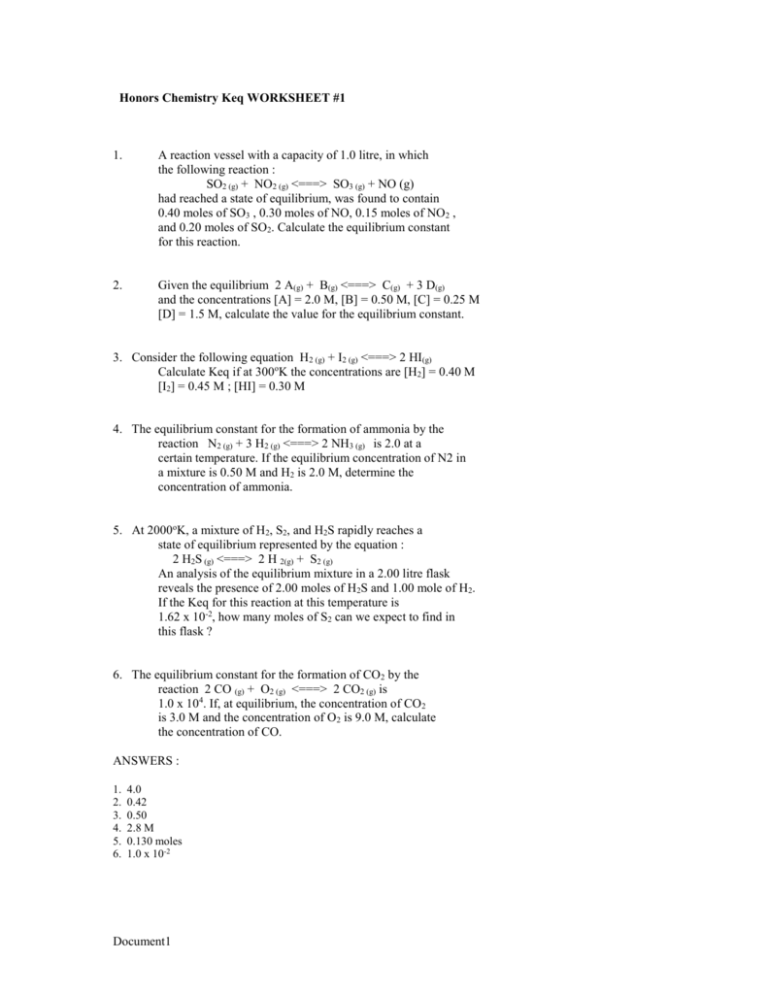
Honors Chemistry Keq WORKSHEET #1 1. A reaction vessel with a capacity of 1.0 litre, in which the following reaction : SO2 (g) + NO2 (g) <===> SO3 (g) + NO (g) had reached a state of equilibrium, was found to contain 0.40 moles of SO3 , 0.30 moles of NO, 0.15 moles of NO2 , and 0.20 moles of SO2. Calculate the equilibrium constant for this reaction. 2. Given the equilibrium 2 A(g) + B(g) <===> C(g) + 3 D(g) and the concentrations [A] = 2.0 M, [B] = 0.50 M, [C] = 0.25 M [D] = 1.5 M, calculate the value for the equilibrium constant. 3. Consider the following equation H2 (g) + I2 (g) <===> 2 HI(g) Calculate Keq if at 300oK the concentrations are [H2] = 0.40 M [I2] = 0.45 M ; [HI] = 0.30 M 4. The equilibrium constant for the formation of ammonia by the reaction N2 (g) + 3 H2 (g) <===> 2 NH3 (g) is 2.0 at a certain temperature. If the equilibrium concentration of N2 in a mixture is 0.50 M and H2 is 2.0 M, determine the concentration of ammonia. 5. At 2000oK, a mixture of H2, S2, and H2S rapidly reaches a state of equilibrium represented by the equation : 2 H2S (g) <===> 2 H 2(g) + S2 (g) An analysis of the equilibrium mixture in a 2.00 litre flask reveals the presence of 2.00 moles of H2S and 1.00 mole of H2. If the Keq for this reaction at this temperature is 1.62 x 10-2, how many moles of S2 can we expect to find in this flask ? 6. The equilibrium constant for the formation of CO2 by the reaction 2 CO (g) + O2 (g) <===> 2 CO2 (g) is 1.0 x 104. If, at equilibrium, the concentration of CO2 is 3.0 M and the concentration of O2 is 9.0 M, calculate the concentration of CO. ANSWERS : 1. 2. 3. 4. 5. 6. 4.0 0.42 0.50 2.8 M 0.130 moles 1.0 x 10-2 Document1 CHEMISTRY 12 Keq WORKSHEET #2 1. A sample containing 0.800 moles of POCl3 is enclosed in a 0.500 litre vessel at a certain temperature. When the equilibrium for the dissociation reaction POCl3 (g) <===> POCl (g) + Cl2 (g) is attained, it is found that the vessel contains 0.259 moles of Cl2. Calculate the equilibrium constant. 2. The brown gas NO2 on cooling is converted into the colourless gas N2O4 as described by the equation 2 NO2(g) <===> N2O4(g) If the original concentration of NO2 is 0.90 M, and at equilibrium its concentration is only 0.26 M, what is the equilibrium constant for the reaction ? 3. SO3 (g) + NO (g) <====> NO2 (g) + SO2 (g) If 0.300 mol of SO3 and 0.300 mol NO were placed in a 1.00 L flask and allowed to react, what would be the equilibrium concentration of each gas ? (Keq = 0.500) 4. 2 HCl (g) <====> H2 (g) + Cl2 (g) If 2.00 mol HCl are placed in a 5.00 L flask and allowed to come to the equilibrium shown above, what will the equilibrium [H2] be ? (Keq = 3.2 x 10 -4) 5. H2 (g) + CO2 (g) <====> CO (g) + H2O (g) If 1.50 mol of each chemical species are placed in a 3.00 L flask and allowed to achieve the equilibrium above, what mass of CO will be present at equilibrium ? (Keq = 3.59) ANSWERS : 1. 2. 3. 4. 5. 0.248 4.7 [SO3] = 0.176 M [NO] = 0.176 M [NO2] = 0.124 M [SO2] = 0.124 M [H2] = 6.9 x 10-3 M 13.0 grams CO Document1

